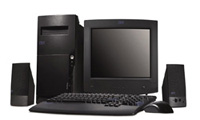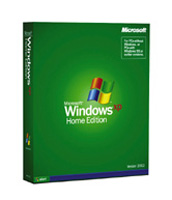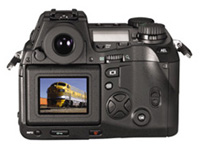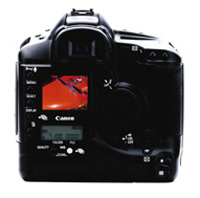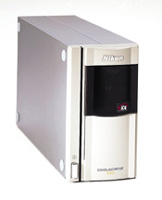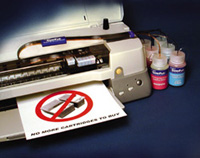Year End Wrap Up
Digital Photography
|
According to IDC Inc., the
number of digital images captured is expected to grow from 3.5 billion
in 1999 to 34 billion in 2004. So it's no wonder that the computer world's
mantra of "bigger, faster, cheaper" was never more obvious than in this
year's crop of digital imaging hardware and software. |
|
Apple Computer, still suffering from processor MHz envy with the galloping speeds of Intel's 1GHz and faster chips, rolled out new models that were (surprise) bigger, faster, and cheaper. The new Silver Power Macintosh G4 machines have faster 867MHz processors--even dual 800MHz processors on one model--along with built-in recordable CD-RW and DVD drives. Even the ubiquitous and not so colorful anymore iMacs were improved, providing speeds of 700MHz, although they still use G3 chips. |
|
Software The biggest software news of the year is that Adobe launched a kid brother to Photoshop called Photoshop Elements. This is the answer to the perennial reader question of, "I'd like to use Photoshop, but it's too expensive; what else can I do?" At $99, Elements includes most of the features non-professional users need--there's no CMYK capability--and features an enhanced interface that echoes Photoshop without copying it. Plus there are a few features not found in Photoshop, including redeye reduction and the best panorama-stitching feature I've seen in any image manipulation program. |
|
My first thought was thJASC's Paint Shop Pro has been around for some time and each new version gets better and better. The newest version, Paint Shop Pro 7.02, features multiple color gradients, and a seemingly endless array of special effects tools and filters, color layers, and a Print Multiple Image command that offers a touch of desktop publishing. Text capabilities are impressive and function in a logical manner. This latest version features expanded file format support, allowing you to save and read files in formats as widely diverse as Amiga, Macintosh PICT, and MacPaint. With a download price under $100, Paint Shop Pro 6 is one of the best ways for Windows users to get acquainted with the art of image manipulation. There's more to image handling than just beating up on a bunch of pixels. Programs such as ACD International's ACDSee 4.0 has almost 40 new features, including a redesigned user interface that creates a comfortable environment for digital newcomers. ACDSee 4.0 supports over 50 image and multimedia formats and lets you organize images and thumbnails into albums, folders, CD-ROMs, and other off-line volumes. Search capabilities include a wide range of characteristics including image attributes, digital camera information, and duplicate content. You can also capture images from a number of sources including screen captures, USB storage devices, and digital cameras. The Mac OS version will be updated to Version 1.6 by year's end to be compatible with Mac OS X, and the next major Macintosh update should be available by Summer 2002. In the meantime, Mac-heads might want to check out iView Media Pro as an alternative. |
|
Digicams |
|
Minolta's Dimage 7 is a 5.2 megapixel camera that features a 28-200mm (equivalent) zoom lens built into an attractive package. Its look-alike sibling, the Dimage 5 has a similar form factor but offers 3.3 megapixel imaging capabilities. Olympus' Camedia E-20N is a
5 megapixel camera that offers dual mode image capture capability: In
Interlaced scan mode every other line is scanned (1, 3, 5, 7, 9, etc.
and then 2, 4, 6, 8, 10) which produces 5 megapixel resolution with a
top shutter speed of 1/640 sec. Selecting the Progressive scan mode cuts
the resolution to 2.5 megapixels but gives users shutter speeds up to
1/18,000 sec while allowing a 4.5 fps burst rate for seven frames. |
|
The question on everyone's
mind is: "When will this megapixel race end?" My guess is that the answer
is never. Manufacturers will keep offering chips that are bigger, faster,
and cheaper, even after they've reached a level that matches film pixel
for grain in 35mm cameras. While we will continue to see bigger and
better digicams, one thing we won't see next year is Silicon Film's
EFS-1 system that lets you shoot digital images with a film camera.
Evidently, the delay and financial strain caused by the need to make
the device pass the FCC's interference test proved to be the final straw.
It was a great concept and technical achievement that never saw fruition.
|
|
Printers It seemed like every time I turned around during 2001, another photo quality printer was announced. This was a year that ink jet printers got better and better, meeting the standard of producing image quality and durability of conventional lab-produced C-prints. Many new printers were introduced this year, including Canon's six-color S800 Bubble Jet printer that delivers 2400x1200dpi output at 15 pages per minute (ppm) in black and 10 ppm in color. Canon's big news is the use of individual ink tanks--one for each color--that have an optical sensor detecting when a tank is low and gives an on-screen warning when ink is running out. At deadline, Epson introduced their six-color Stylus Photo 820 printer that has a $149 price tag. (As I write this there is a $50 rebate.) The 2880x720dpi printer has a maximum printable area of 8.5x11", allowing it to print 4x6, 5x7, and 8x10 borderless prints. Windows and USB connectivity offer compatibility with Mac OS and Windows computers. Hewlett-Packard's $399 PhotoSmart 1215 photo quality ink jet printer provides built-in CompactFlash and SmartMedia memory card slots enabling it to print directly from a digital camera--with no computer required. Although what will happen to this popular line of ink jet printers in light of the Compaq merger won't be revealed until 2002. Lexmark's Z53 Color Jetprinter looks much more expensive than its $139 price tag and offers parallel port and USB connections as well as drivers for Linux, Mac OS, and Windows owners. |
|
Ink, paper, and accessories also made 2001 a banner year for digital printing. Luminos Photo Corp's LumiFlo Fluidic Ink Delivery System eliminates the use of ink cartridges for Epson's Stylus Photo 1270/1280 printers. Their system includes the LumiFlo Fluidic Ink Delivery Device; six 4-oz bottles of Preservation Series LumiFlo Gold Ink; a Preservation Series Sampler Pak that includes 10 sheets of five Preservation Series fine art paper; and a CD-ROM with 1270/1280 ICC (International Color Consortium) profiles for color management. Since there are no cartridges to replace, the system reduces the amount of time spent changing cartridges and running repetitive nozzle checks and clean cycles. Replacement ink will be sold separately in individual 6-oz bottles. Luminos claims that their LumiFlo Fluidic Ink Delivery System can reduce ink costs up to 60 percent. |
|
Epson's gelatin-coated ColorLife Photo Paper has a rated lightfastness of 25-27 years before noticeable fading is expected. ColorLife's surface has a light texture and a 1440dpi limit even if your printer, like the Stylus Photo 820, can output at 2880dpi. It's not compatible with borderless printing like other Epson paper offerings, but is an ideal media to use when longevity is your goal. I make wallet-sized prints using Adobe Photoshop's File>Automate> Picture Package command to produce archival snapshots to mail to family members. Are you tired of dragging printer cables all over the house? Want to use an Epson Stylus Photo 2000P but don't have space in your digital darkroom? Epson's Wireless Printer Server lets you place your printer anywhere within 300 ft of your computer and will even transmit--it uses radio--through walls and floors. Apple fans will recognize the 802.11b technology Epson uses as AirPort. The server costs $249 and ends forever the hassle of "where do I put that printer cable?" |
- Log in or register to post comments
